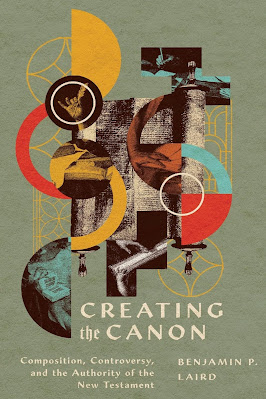Creating the Canon: Composition, Controversy, and the Authority of the New Testament. By Benjamin P. Laird. Downers Grove: InterVarsity Press, 2023, xiv, + 258 pp., $30.00 paperback.
The historical circumstances surrounding the writing, distribution, selection and gathering together of the New Testament documents continues to garner much scholarly attention. Yet, there are few books that attempt to condense the nuanced historical details into an easily digestible introduction. Creating the Canon is the latest in a steady stream of new books by Benjamin P. Laird and was written in order to fulfill this need. Laird earned his PhD at the University of Aberdeen and is an Associate Professor of Biblical Studies at the John W. Rawlings School of Divinity at Liberty University in Lynchburg, Virginia.
The book is segmented into three segments. Part one consists of three chapters and covers "Questions Relating to the Production of the New Testament Writings" (pp. 11-84).
Chapter 1, "The Composition of the New Testament Writings," advances the notion that many of the writings of the New Testament were composed through the collaborative efforts of a team of secretaries, letter carriers, and others who took part in distributing the canonical writings.
Chapter 2, "The Original Autographs of the New Testament Writings," proposes that many of the New Testament writings had multiple autographs. It is argued that it is better to think of an "original edition" rather than an "original autograph" (p. 64).
Chapter 3, "The Original Readers of the New Testament Writings," articulates the idea that the canonical authors wrote with multiple communities in view rather than a single audience. This concept would mean that the New Testament writings were composed with a more universal message in mind.
Part two is the largest segment of the work and consists of three chapters, addressing "Questions Relating to the Formation of the New Testament Canon" (pp. 87-174).
Chapter 4, "Theological Controversies and the Formation of the New Testament Canon," engages with popular assumptions that are postulated as causing the formation of the New Testament Canon. The controversies surrounding Marcion, and the notion that early Church councils in the fourth century decided the canon, are discussed.
Chapter 5, "The Primary Witnesses to the Early State of the New Testament Canon," surveys the early patristic canonical lists and references to the canonical writings. The chapter also introduces the reader to some of the most important and early copies of the New Testament writings.
Chapter 6, "The Canonical Subcollections and the Formation of the New Testament Canon," highlights the influence that canonical "subcollections" had on the acceptance of the twenty seven books of the New Testament.
Part three is the shortest section of the book with only two chapters and engages with "Questions Relating to the Authority of the New Testament Canon" (p. 177-236).
Chapter 7, "Apostolicity and the Formation of the New Testament Canon," discusses the relationship of apostolic teaching and authority with the reception of many of the New Testament writings.
Chapter 8, "Apostolic Authorship and the Authority of the New Testament Canon," evaluates several modern scholarly perspectives on the foundations for the continuing authority of the New Testament writings.
Though the book functions as an introduction to the topic, it attempts to cover too many competing scholarly perspectives. Readers may find it difficult to find the common thread of thought through the various chapters. Related to this, many may have difficulty finding a clear thesis or main argument in the book.
Because the work attempts to engage with too many scholarly perspectives, often inadequate space is given when Laird supports a particular scholarly position. For example, because of the various textual problems surrounding the last chapters of Romans, Laird proposes that three copies of the "longer recension" of Romans were made, "one for the Romans, one for those in Corinth, and one for Paul and/or his associates" (pp. 61-62). Laird proposes that the secretaries or scribes of Paul (i.e. Tertius), in preparing a copy of Romans to be sent to the Corinthians, removed the irrelevant material at the end of Romans (p. 62). This would "explain both the origin of the shorter and longer recensions as well as the alternative locations of the doxology" (p. 62). Unfortunately, Laird does not expound on the reasons why a scribe such as Tertius would go to the trouble of removing irrelevant material at the end of Romans, but would retain the most irrelevant textual address, "to all those in Rome" (Rom. 1:7, 1:15), at the beginning of the letter. The fact that there are almost no Greek manuscripts that lack this address seems to be a significant hurdle to this explanation of the textual variation at the end of Romans.
Despite these criticisms, Creating the Canon would work well as a starting point for forays into the study of New Testament canon formation. Readers will be introduced to first century composition practices, the role of letter carriers, and the early process of gathering of these writings into subcollections. Chapter two, which discussed the issues surrounding the "autographs," and chapters seven and eight, concerning the issue of apostolic authority and canon formation, engaged with topics rarely seen in books on the New Testament canon. This work might prove useful as a textbook for a college or seminary class on the New Testament Canon.
Timothy N. Mitchell
PhD, University of Birmingham, UK



No comments:
Post a Comment